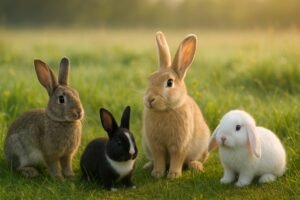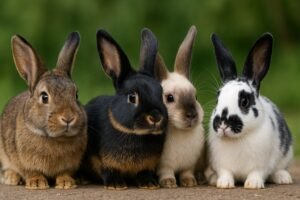If you’re a rabbit owner, you might have wondered whether straw is a good option for your furry friend. This article will explore whether rabbits can have straw, whether it’s safe to eat, and how straw compares to other types of bedding and hay. Let’s investigate the details to ensure your bunny stays secure and comfortable!
Quick Points
- Straw is different from hay and has less nutritional value.
- It can be used as bedding, but should not be the primary food source.
- Hay, such as timothy or orchard grass hay, is more suitable for a rabbit’s diet.
- Straw is less dusty and can help keep rabbits warm.
- Be cautious if your rabbit is eating too much straw, as it doesn’t provide the nutrients they need.
What is Straw, and Can Rabbits Have It?
Straw is a dried stalk, typically from cereal plants like wheat or barley, which is often used as bedding material for animals. While straw is safe for rabbits to interact with, it is important to understand its role and how it compares to hay.
Rabbits can have straw as bedding because it is soft, absorbent, and provides warmth. However, it’s not recommended as a main food source because it lacks the vital nutrients that rabbits need to stay healthy. Straw doesn’t have the nutritional benefits that hay, like timothy or orchard grass, offers, as it contains very little protein and fiber. Straw’s hollow stalks trap warm air, providing excellent insulation and keeping rabbits warm in colder climates.
Is Straw Safe for Rabbits to Eat?
Rabbits might nibble on straws, but eating straws doesn’t provide much nutritional value. Unlike hay, which is harvested specifically to feed animals and is full of nutrients, straw lacks the necessary fiber and vitamins that are vital for your bunny’s digestive health.
Hay, such as timothy hay, alfalfa hay (for young rabbits), or oat hay, is a much better option for feeding rabbits. These types of hay are rich in fiber, which is crucial for maintaining a rabbit’s gut health and preventing digestive issues. If your rabbit is eating too much straw, it might be a sign that they don’t have enough fresh hay available.
Straw vs. Timothy Hay: Understanding the Difference
Straw is mostly used as bedding. It’s lightweight, low in dust, and can provide good insulation for rabbits, keeping them warm during cold winter months.
Hay, on the other hand, is a key component of a rabbit’s diet. It should make up about 80-90% of what they eat. Timothy hay, orchard grass hay, and oat hay are all excellent choices for rabbits because they are full of fiber and help maintain dental health by wearing down their teeth naturally.

Types of Hay Suitable for Rabbits
Rabbits are herbivores, which means they exclusively consume plant materials. In the wild, rabbits feast on a wide variety of plants, ingesting large quantities of fresh grass daily. To satisfy a rabbit’s natural craving for grass, the best and most practical solution is to provide them with unlimited access to fresh, high-quality grass hay. Here are some types of hay that are suitable for rabbits:
Timothy Hay: A Popular Choice for Rabbits
Timothy hay is the most widely used and favored hay for rabbits. Veterinarians often recommend it as an ideal choice for bunnies of all sizes and breeds. Timothy hay offers a delightful balance of taste and texture that most rabbits adore while supplying the high fiber, balanced protein, and calcium necessary for maintaining their digestive and dental health. Grass Hay: A Sweet and Soft Option.
Orchard grass hay is a softer and slightly sweeter alternative to Timothy hay. It can be a great option for rabbits that aren’t consuming as much hay as they should. By combining Orchard Grass with Timothy hay, you can offer an enriching mix of flavors and textures that your rabbits will enjoy.
Grass Hay: A General Term for Various Types of Hay
Grass hay is a general term for various types of hay that are suitable for rabbits. It is a good option for rabbits as it is less likely to be eaten compared to other bedding materials. Grass hay is also a good choice for rabbits as it is easy to clean and replace.

Straw Bedding as Bedding Material
Straw makes for great bedding for rabbits because it is soft and helps keep them warm, particularly in colder climates. Using straw as bedding can also help keep the rabbit’s litter box area clean and minimize waste. Many pet owners also appreciate that straw is a natural material that can be easily composted after use. It is less absorbent than some other bedding materials like wood shavings or cat litter, but it is still effective at providing a comfortable space for rabbits to rest.
You can also consider shredded paper, wood shavings, or even specialized litter for bedding, but it’s essential to avoid anything that may have harmful chemicals. When using straw, make sure it’s clean and free from dust or mold to ensure your rabbit’s safety.
Health Considerations for Rabbits on Straw Bedding
While straw bedding is a popular choice for rabbits, there are some health considerations to keep in mind.
Potential Health Risks Associated with Straw Bedding
Rabbits can ingest bacteria-filled straw or hay, causing breathing problems or skin infections. Rabbits can also become very ill from bacteria in food, which can result from dirty or damp straw bedding. It is essential to keep the cage clean and replace the straw bedding frequently to prevent these health risks.
Additionally, rabbits can eat straw, but it has few nutrients and should be supplemented with good-quality hay. Over-reliance on straw as a food source can lead to nutrient deficiencies and health problems. A rabbit’s diet should consist of 80% hay, 10% pellets, and 10% fresh vegetables and fruits.
It is also important to note that straw bedding can be a potential allergen for some rabbits, causing respiratory problems. If you have high-quality respiratory distress or allergic reactions in your rabbit, it is best to switch to a different bedding material.
Overall, while straw bedding can be a good option for rabbits, it is essential to monitor their health and adjust their diet and bedding accordingly to prevent any potential health risks.
Should Rabbits Eat Straw?
While straw is safe if a rabbit nibbles on it occasionally, it should not be fed as a primary food source. Straw doesn’t contain enough fiber or nutritional content to sustain a rabbit’s health. Instead, make sure your rabbit has plenty of fresh hay, as well as pellets and fresh greens to complement their diet.
Hay helps wear down their teeth, keeps their gut moving, and provides the nutrients rabbits need. Feeding them mainly straw can lead to nutritional deficiencies and other health issues in the long run.
Common Questions (FAQs)
1. Can rabbits eat straw instead of hay?
No, straw does not have the same nutritional value as hay. It’s best used as bedding, while hay should be the primary food source for rabbits.
2. Is straw good for keeping rabbits warm?
Yes, straw can be a good insulator and is effective at keeping rabbits warm, especially in colder climates. It’s great to use as bedding material for this reason.
3. What’s the best type of hay for rabbits?
Timothy hay is generally the best choice for adult rabbits due to its high fiber content. Young rabbits can also benefit from alfalfa hay, but it should be limited for adults due to its higher protein and calcium content.
4. Can straw be harmful to rabbits?
Straw is not harmful if nibbled occasionally, but it lacks the essential nutrients that rabbits need in their diet. If a rabbit relies on straw as their primary food, it could lead to nutritional deficiencies.
5. What other bedding materials can be used for rabbits?
In addition to straw, you can use wood shavings (avoid cedar or pine due to harmful oils), shredded paper, or paper-based litter. Just ensure that the bedding is non-toxic and safe for rabbits.
Final Thoughts
Straw can be a great addition to your rabbit’s environment, but it’s crucial to use it correctly. As bedding, it’s effective and helps keep your bunny comfortable. As food, however, it’s not ideal—hay should be the main component of their diet. Always ensure your rabbit has access to plenty of fresh hay, clean water, and a safe and cozy space to rest.
If you’re ever unsure about what to feed your rabbit or what bedding to use, it’s always a good idea to consult with a vet who understands rabbits’ unique needs.



